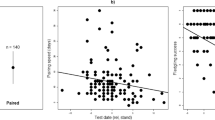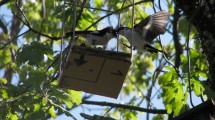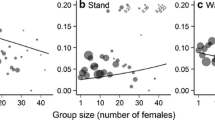Abstract
Trade-offs between reproductive effort and activities that are likely to enhance survival have been studied extensively in harem defense ungulates. However, among resource defense systems, ecological determinants of the variation in male reproductive effort are less understood. The aim of this study was to assess the extent of the effort devoted to territorial defense by male guanacos and how this is affected by predation risk. Time allocation to different activities and displays of aggressive behavior were compared between territorial and bachelor male guanacos within two populations with contrasting levels of predation risk. Territorial males devoted almost twice the time than bachelors to vigilance and moving, at the expense of foraging time. Aggressive interactions were more frequent and severe for territorial males than for bachelors, based on observation. These differences were larger during the reproductive season but remained statistically significant after this period, highlighting the extended effort towards territorial defense beyond the peak of reproductive activity. In contrast to previous observations on females of the same populations, there was no effect of predation risk level or group size on male time allocation, suggesting that under the ecological conditions of the study, intra-sexual competition entails a stronger influence on male individual behavior than predation risk level.

Similar content being viewed by others
References
Altmann J (1974) Observational study of behaviour: sampling methods. Behaviour 49:227–267
Baldi R, Albon SD, Elston DA (2001) Guanacos and sheep: evidence for continuing competition in arid Patagonia. Oecologia 129:561–570
Baldi R, Pelliza Sbriller A, Elston D, Albon SD (2004) High potential for competition between guanacos and sheep in Patagonia. J Wildl Manag 68:924–938
Bank MS, Sarno RJ, Franklin WL (2003) Spatial distribution of guanaco mating sites in southern Chile: conservation implications. Biol Conserv 112:427–434
Beauchamp G (2008) What is the magnitude of the group-size effect on vigilance? Behav Ecol 19:1361–1368
Beeskow AM, Del Valle HF, Rostagno CM (1987) Los sistemas fisiográficos de la región árida y semiárida de la Provincia de Chubut. Publicación Especial, Secretaría de Ciencia y Técnica, Buenos Aires
Buckland ST, Anderson DR, Burnham KP, Laake JL (1993) Distance Sampling: estimating abundance of biological populations. Chapman & Hall, London
Cévoli SR (2005) Dinámica de la población de guanacos (Lama guanicoe, Müller) de la reserva Cabo Dos Bahías, Chubut. PhD thesis. Universidad Nacional de la Patagonia, Patagonia
Childress MJ, Lung MA (2003) Predation risk, gender and the group size effect: does elk vigilance depend upon the behaviour of conspecifics? Anim Behav 66:389–398
Clutton-Brock TH, Guinness FE, Albon SD (1982) Red deer: behaviour and ecology of two sexes. University of Chicago Press, Chicago
Crawley MJ (1993) GLIM for ecologists. Blackwell, Cambridge
Crawley MJ (2007) The R book. Wiley, Chichester
Davies NB, Houston AI (1984) Territory economics. In: Krebs CJ, Davies NB (eds) Behavioural ecology. Blackwell Scientific Publications, Oxford, pp 148–169
Franklin WL (1983) Contrasting socioecologies of South America’s wild camelids: the vicuña and the guanaco. Am Soc Mam Spec Publ 7:573–628
Gosling LM (1982) A reassessment of the function of scent marking in territories. Z Tierpsychol 60:89–118
Hunter L, Skinner JD (1998) Vigilance behavior in African ungulates: the role of predation pressure. Behaviour 135:195–211
Lima SL (1995) Back to the basics of anti-predatory vigilance: the group size effect. Anim Behav 49:11–20
Logan KA, Irwin LL (1985) Mountain lion habitats in the Bighorn Mountains, Wyoming. Wild Soc Bull 13:257–262
Lung MA, Childress MJ (2007) The influence of conspecifics and predation risk on the vigilance of elk (Cervus elaphus) in Yellowstone National Park. Behav Ecol 18:12–20
Marino A (2010) Costs and benefits of sociality differ between female guanacos living in contrasting ecological conditions. Ethology 116:1–12
Marino A, Baldi R (2008) Vigilance patterns of territorial guanacos (Lama guanicoe): the role of reproductive interests and predation risk. Ethology 114:413–423
Oliva G, Humano G, Rial P, González L, Paredes P, Mascó M, Kofalt R, Ferrante D, Franchini C, Vivar E (2006) Estudio de línea de base y plan de monitoreo de la biodiversidad vegetal del Parque Nacional Monte León. INTA, Santa Cruz
Ottoni EB (2000) EthoLog 2.2: a tool for the transcription and timing of behavior observation sessions. Behav Res Methods Instrum Comput 32:446–449
Pettorelli N, Olav Vik J, Mysterud A, Gaillard JM, Tucker CJ, Stenseth NC (2005) Using the satellite-derived NDVI to assess ecological responses to environmental change. Trends Ecol Evol 20:503–510
Pia MV, Novaro AJ (2005) Monitoreo de poblaciones de carnívoros y análisis de alternativas para reducir conflictos con la ganadería en el área circundante al Parque Nacional Monte León. Fundación Patagonia Natural, Administración de Parques Nacionales, Argentina
Pulliam RH (1973) On the advantage of flocking. J Theor Biol 38:419–422
Pulliam RH, Caraco T (1984) Living in groups: is there an optimal group size? In: Krebs CJ, Davies NB (eds) Behavioural ecology. Blackwell Scientific Publications, Oxford, pp 122–147
Raedeke KJ (1979) Population dynamics and socioecology of the guanaco (Lama guanicoe) of Magallanes, Chile. PhD thesis. University of Washington, Seattle
Sokal RR, Rohlf FJ (1995) Biometry: the principles and practices of statistics in biological research. WH Freeman, New York
Travaini A, Zanón Martínez JI (2008) Puesta a prueba de la extinción ecológica de presas autóctonas del puma (Puma concolor) en Patagonia. UNPA, Puerto Deseado
Vehrencamp SL, Bradbury JW (1984) Mating systems and ecology. In: Krebs CJ, Davies NB (eds) Behavioural ecology. Blackwell Scientific Publications, Oxford, pp 251–278
Vilá BL (1992) Vicuñas (Vicugna vicugna) agonistic behaviour during the reproductive season. In: Spitz F, Janeau G, Gonzalez G, Aulagnier S (eds) Ongules/Ungulates/91, Proc Int Symp. SFEPM/IRGM, Toulouse, pp 475-482
Young JK, Franklin WL (2004a) Activity budget patterns in family-group and solitary territorial male guanacos. Rev Chil Hist Nat 77:617–625
Young JK, Franklin WL (2004b) Territorial fidelity of male guanacos in the Patagonia of Southern Chile. J Mammal 85:72–78
Acknowledgments
I want to thank to Lorena Martinez and Pablo Rosso for their assistance with the behaviural observations at ML; Alejo Irigoyen, Marcela Nabte, Martín Zamero, Victoria Rodriguez, and Gustavo Pazos, Bambino Neira, Mariana Martinez, and all the staff of Monte León National Park, for their support in the field work; Centro Nacional Patagónico and Consejo Nacional de Investigaciones Científicas y Técnicas, for providing support and logistical facilities; Alejo Irigoyen, Mark Hewison and an anonymous reviewer for their comments on this manuscript. The field work was possible thanks to the financial support provided by the Rufford Small Grant Foundation.
Author information
Authors and Affiliations
Corresponding author
About this article
Cite this article
Marino, A. Indirect measures of reproductive effort in a resource-defense polygynous ungulate: territorial defense by male guanacos. J Ethol 30, 83–91 (2012). https://doi.org/10.1007/s10164-011-0299-4
Received:
Accepted:
Published:
Issue Date:
DOI: https://doi.org/10.1007/s10164-011-0299-4




